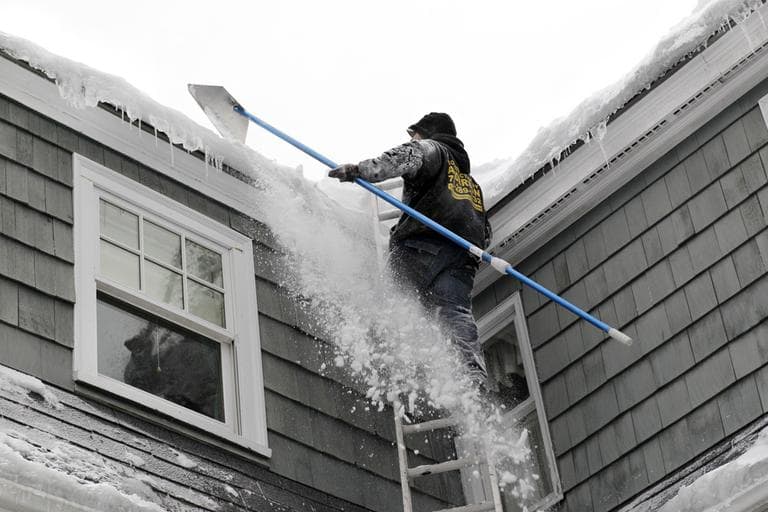Advertisement
Mammoth Storm Leaves Bitter Cold, Destruction

An enormous winter storm left Midwesterners shivering in its frozen footprint and crushed snow-laden buildings in the Northeast, where a combination of ice, snow and rain pushed much of the winter-cursed region to its breaking point.
Wind chills were expected to dip to 30 below in parts of the nation's midsection before the region awoke Thursday to deal with the storm's aftermath. The sprawling system unloaded as much as 2 feet of snow, crippled airports and stranded drivers in downtown Chicago as if in a prairie blizzard. Much of Texas was under a hard freeze warning Wednesday; light snowfall stubbornly lingered into the night in Maine.
Officials in the Northeast had warned homeowners and businesses for days of the dangers of leaving snow piled up on rooftops. As the 2,000-mile-long storm cloaked the region in ice and added inches to the piles of snow already settled across the landscape, the predictions came true. No one was seriously injured, however.
In Middletown, Conn., the entire third floor of a building failed, littering the street with bricks and snapping two trees. Acting Fire Marshal Al Santostefano said two workers fled when they heard a cracking sound.
"It's like a bomb scene," Santostefano said. "Thank God they left the building when they did."
A gas station canopy on New York's Long Island collapsed, as did an airplane hangar near Boston, damaging aircraft. Roof cave-ins also were reported in Rhode Island. The University of Connecticut closed its hockey rink as a precaution because of the amount of ice and snow on the roof. The school hoped to have it inspected and reopened in time for a game Saturday.
Some places in the Northeast that have gotten more snow so far this winter than they usually get the whole season are running out of places to put it. In Portland, Maine, the downtown snow-storage area was expected to reach capacity after this week's storm - the first time in three years that has happened.
"It's not so much about plowing as it is about where to put it," said Mike Schumaker, a contractor near Albany, N.Y. "We still have snow from Christmas that hasn't melted."
Snow totals in the Northeast hit their peak at several inches in New England, a far cry from the foot or more the region has come to expect with each passing storm in a season full of them. Meanwhile, the Midwest was reeling from the storm's wallop as the system swept eastward.
Tens of millions of people stayed home Wednesday. The hardy few Midwesterners who ventured out faced howling winds that turned snowflakes into face-stinging needles. Chicago's 20.2 inches of snow was the city's third-largest amount on record.
Across the storm's path, lonely commuters struggled against drifts 3 and 4 feet deep in eerily silent streets, some of which had not seen a plow's blade since the snow started a day earlier. Parkas and ski goggles normally reserved for the slopes became essential for getting to work.
"This is probably the most snow I've seen in the last 34 years," joked 34-year-old Chicagoan Michael George. "I saw some people cross-country skiing on my way to the train. It was pretty wild."
The system was blamed for at least 12 deaths, including a homeless man who burned to death on Long Island as he tried to light cans of cooking fuel and a woman in Oklahoma City who was killed while being pulled behind a truck on a sled that hit a guard rail.
Airport operations slowed to a crawl nationwide, and flight cancellations reached 13,000 for the week, making this system the most disruptive so far this winter. A massive post-Christmas blizzard led to about 10,000 cancellations.
Chicago public schools canceled classes for a second straight day. And the city's iconic Lake Shore Drive remained shut down, nearly a day after drivers abandoned hundreds of vehicles stopped in their tracks by snow that drifted as high as the windshields.
Some motorists came away angry, frustrated that the city didn't close the crucial thoroughfare earlier. Others were mad at themselves for going out during the storm or not using another route.
"In 31 years with the city, I haven't experienced anything like we did at Lake Shore Drive," said Raymond Orozco, chief of staff for Mayor Richard M. Daley. "Hundreds of people were very inconvenienced, and we apologize for that."
City crews who worked into the night Wednesday were aiming to have Lake Shore Drive passable for the morning rush hour.
Utility crews raced to restore power to thousands of homes and businesses in Ohio, New Jersey and Pennsylvania, where freezing rain and ice brought down electrical lines.
Rolling blackouts were implemented across Texas, including in Super Bowl host city Dallas, because of high demand during a rare ice storm. The outages would not affect Cowboys Stadium in suburban Arlington, said Jeamy Molina, a spokeswoman for utility provider Oncor. But other Super Bowl facilities, such as team hotels, were not exempt, she said.
The storm derived its power from the collision of cold air sweeping down from Canada and warm, moist air coming up from the South. Weather experts said La Nina, a temperature phenomenon in the Pacific Ocean, also contributed.
"The atmosphere doesn't like that contrast in temperature. Things get mixed together and you have a storm like this," said Gino Izzo, a National Weather Service meteorologist. "The jet stream up in the atmosphere was like the engine and the warm air was the fuel."
Snowfall totals this winter are off the charts along parts of the Interstate 95 corridor between Boston and Philadelphia.
Newark, N.J., was hit with 62 inches of snow through Jan. 27, compared with the seasonal average of 25 inches. In New York City, 56 inches of snow has fallen on Central Park, compared to the 22-inch seasonal average.
This program aired on February 3, 2011. The audio for this program is not available.